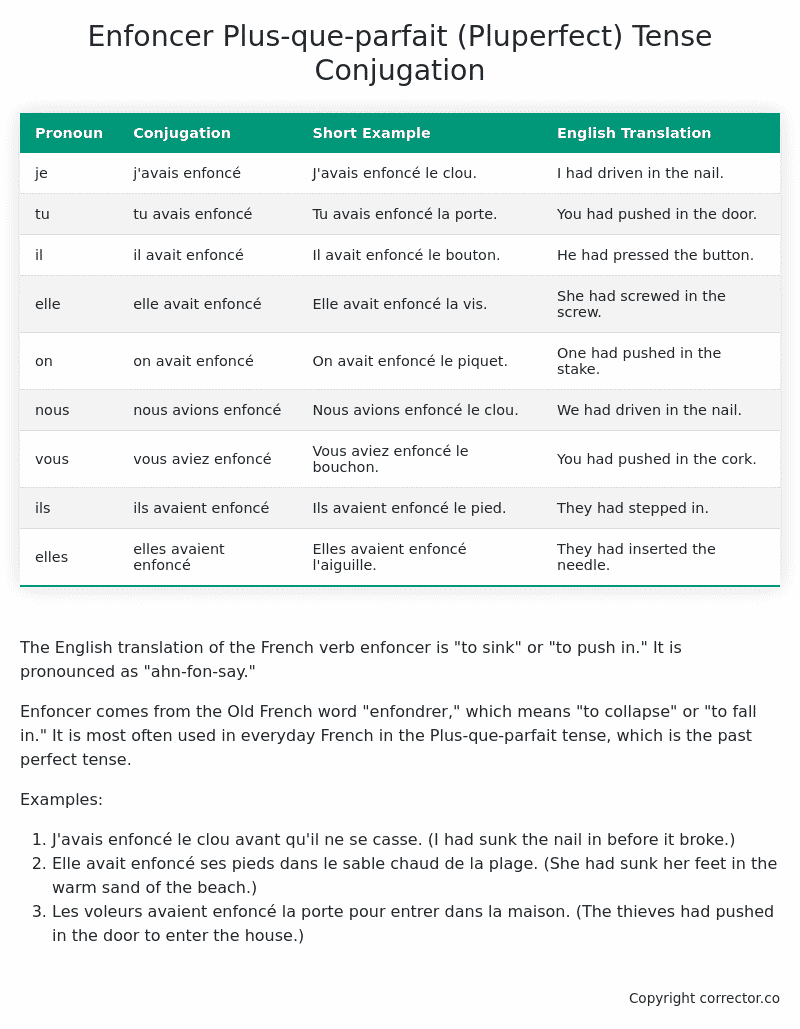Plus-que-parfait (Pluperfect) Tense Conjugation of the French Verb enfoncer
Introduction to the verb enfoncer
The English translation of the French verb enfoncer is “to sink” or “to push in.” It is pronounced as “ahn-fon-say.”
Enfoncer comes from the Old French word “enfondrer,” which means “to collapse” or “to fall in.” It is most often used in everyday French in the Plus-que-parfait tense, which is the past perfect tense.
Examples:
- J’avais enfoncé le clou avant qu’il ne se casse. (I had sunk the nail in before it broke.)
- Elle avait enfoncé ses pieds dans le sable chaud de la plage. (She had sunk her feet in the warm sand of the beach.)
- Les voleurs avaient enfoncé la porte pour entrer dans la maison. (The thieves had pushed in the door to enter the house.)
Table of the Plus-que-parfait (Pluperfect) Tense Conjugation of enfoncer
| Pronoun | Conjugation | Short Example | English Translation |
|---|---|---|---|
| je | j’avais enfoncé | J’avais enfoncé le clou. | I had driven in the nail. |
| tu | tu avais enfoncé | Tu avais enfoncé la porte. | You had pushed in the door. |
| il | il avait enfoncé | Il avait enfoncé le bouton. | He had pressed the button. |
| elle | elle avait enfoncé | Elle avait enfoncé la vis. | She had screwed in the screw. |
| on | on avait enfoncé | On avait enfoncé le piquet. | One had pushed in the stake. |
| nous | nous avions enfoncé | Nous avions enfoncé le clou. | We had driven in the nail. |
| vous | vous aviez enfoncé | Vous aviez enfoncé le bouchon. | You had pushed in the cork. |
| ils | ils avaient enfoncé | Ils avaient enfoncé le pied. | They had stepped in. |
| elles | elles avaient enfoncé | Elles avaient enfoncé l’aiguille. | They had inserted the needle. |
Other Conjugations for Enfoncer.
Le Present (Present Tense) Conjugation of the French Verb enfoncer
Imparfait (Imperfect) Tense Conjugation of the French Verb enfoncer
Passé Simple (Simple Past) Tense Conjugation of the French Verb enfoncer
Passé Composé (Present Perfect) Tense Conjugation of the French Verb enfoncer
Futur Simple (Simple Future) Tense Conjugation of the French Verb enfoncer
Futur Proche (Near Future) Tense Conjugation of the French Verb enfoncer
Plus-que-parfait (Pluperfect) Tense Conjugation of the French Verb enfoncer (this article)
Passé Antérieur (Past Anterior) Tense Conjugation of the French Verb enfoncer
Futur Antérieur (Future Anterior) Tense Conjugation of the French Verb enfoncer
Subjonctif Présent (Subjunctive Present) Tense Conjugation of the French Verb enfoncer
Subjonctif Passé (Subjunctive Past) Tense Conjugation of the French Verb enfoncer
Subjonctif Imparfait (Subjunctive Imperfect) Tense Conjugation of the French Verb enfoncer
Subjonctif Plus-que-parfait (Subjunctive Pluperfect) Tense Conjugation of the French Verb enfoncer
Conditionnel Présent (Conditional Present) Tense Conjugation of the French Verb enfoncer
Conditionnel Passé (Conditional Past) Tense Conjugation of the French Verb enfoncer
L’impératif Présent (Imperative Present) Tense Conjugation of the French Verb enfoncer
L’infinitif Présent (Infinitive Present) Tense Conjugation of the French Verb enfoncer
Struggling with French verbs or the language in general? Why not use our free French Grammar Checker – no registration required!
Get a FREE Download Study Sheet of this Conjugation 🔥
Simply right click the image below, click “save image” and get your free reference for the enfoncer Plus-que-parfait tense conjugation!

Enfoncer – About the French Plus-que-parfait (Pluperfect) Tense
Tense Formation
Common everyday usage patterns
Sequencing of past events
Background information
Hypothetical or reported speech
Interactions with other tenses
Summary
I hope you enjoyed this article on the verb enfoncer. Still in a learning mood? Check out another TOTALLY random French verb conjugation!


